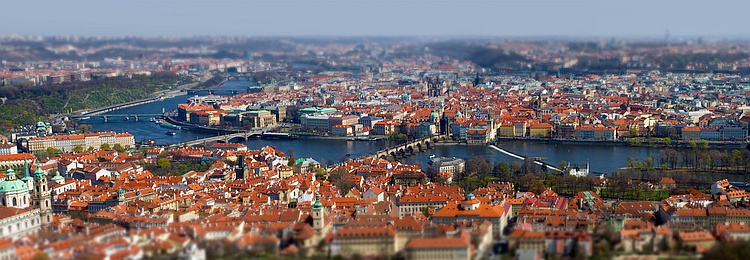About Prague and Czech Republic
 Czech Republic, is a landlocked country in Central Europe. The country is bordered by Germany to the north-west and west, Austria to the south, Slovakia to the east and Poland to the north-east. Prague is the capital and largest city, with 1.3 million residents. The Czech Republic includes the historical territories of Bohemia and Moravia, and Czech Silesia.
Czech Republic, is a landlocked country in Central Europe. The country is bordered by Germany to the north-west and west, Austria to the south, Slovakia to the east and Poland to the north-east. Prague is the capital and largest city, with 1.3 million residents. The Czech Republic includes the historical territories of Bohemia and Moravia, and Czech Silesia.
The Czech landscape is exceedingly varied. Bohemia, to the west, consists of a basin drained by the Elbe and the Vltava (or Moldau) rivers, surrounded by mostly low mountains, such as the Krkonoše range of the Sudetes. The highest point in the country, Sněžka at 1,602 m (5,256 ft), is located here. Moravia, the eastern part of the country, is also quite hilly. It is drained mainly by the Morava River, but it also contains the source of the Oder River.

Prague is the capital and largest city of the Czech Republic. It is the fourteenth-largest city in the European Union. It is also the historical capital of Bohemia. Situated in the north-west of the country on the Vltava River, the city is home to about 1.24 million people, while its larger urban zone is estimated to have a population of nearly 2 million. The city has a temperate climate, with warm summers and chilly winters.
Prague has been a political, cultural, and economic centre of central Europe with waxing and waning fortunes during its 1,100-year existence. Founded during the Romanesque and flourishing by the Gothic and Renaissance eras, Prague was not only the capital of the Czech state, but also the seat of two Holy Roman Emperors and thus also the capital of the Holy Roman Empire. It was an important city to the Habsburg Monarchy and its Austro-Hungarian Empire and after World War I became the capital of Czechoslovakia. The city played major roles in the Protestant Reformation, the Thirty Years' War, and in 20th-century history, during both World Wars and the post-war Communist era.
Prague is home to a number of famous cultural attractions, many of which survived the violence and destruction of 20th-century Europe. Main attractions include the Prague Castle, the Charles Bridge, Old Town Square, the Jewish Quarter, the Lennon Wall and Petřín hill. Since 1992, the extensive historic centre of Prague has been included in the UNESCO list of World Heritage Sites. Prague is the capital of the Czech Republic, which used to be joined with Slovakia until the two separated into distinct sovereign states in 1993.
The city boasts more than ten major museums, along with numerous theatres, galleries, cinemas, and other historical exhibits. A modern public transportation system connects the city. Also, it is home to a wide range of public and private schools, including Charles University. Prague is classified as an Alpha- global city according to GaWC studies, comparable to Vienna, Seoul and Washington, D.C. Its rich history makes it a popular tourist destination, and the city receives more than 4.4 million international visitors annually, as of 2011. In 2011, Prague was the sixth-most-visited city in Europe. Prague ranked fifth in the Tripadvisor world list of best destinations in 2014.
Recommended web sites
- Prague on Wikipedia
- City of Prague Official Site
- Czech Republic travel guide & Prague travelguide from Wikitravel

